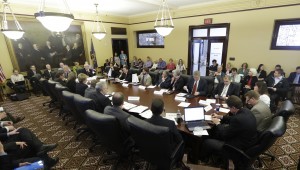SALT LAKE CITY (AP) — The federal government has approved Utah to become the first state to have a dual-model health insurance exchange in which the state and the federal government divide responsibilities.
The plan allows Utah to continue to run its existing health insurance marketplace for small businesses, a system that lets employees pick health care plans in an online exchange. The federal government will run the state’s individual exchange. The two marketplaces will operate independently of each other.
Gov. Gary Herbert first requested this arrangement in February, and the two sides had been negotiating since. Gary Cohen, head of the Center for Consumer Information and Insurance Oversight, announced the agreement’s approval in a letter sent to the governor Friday.

Other states will have the option to consider this model after the U.S. Health and Human Services approves an official rule allowing Utah’s deal to go forward.
Herbert said in a conference call with media Friday that it was an important and historic day for Utah. He emphasized that the state didn’t back down in negotiations. For example, he said, Utah made sure the government knew it would not share information about its residents or businesses with a federal database.
“They’ve granted us everything that we asked for, and for that I’m grateful,” Herbert said.
He applauded Health and Human Services Secretary Kathleen Sebelius for her willingness to work with Utah in crafting a plan that works for both sides. The governor said Sebelius told him in February she hoped to find a way to say yes to Utah’s proposal.
“That’s proven prophetic,” he said. “We’ve found a way to get to yes with this announcement today.”
Health and Human Services granted the request after carefully review, agency spokesman Fabien Levy said.
Until now, states have been choosing from three options:
— Federally run exchanges in which states default to the U.S. government, a plan selected by 26 states.
— State-run exchanges in which states operate their own marketplaces, a plan chosen by 17 states.
— Federal-state partnerships in which the two sides work together, a plan chosen by seven states.
Utah’s model is different in that the two sides will work totally independently of each other — Utah as it continues to improve and expand its small business exchange created in 2009, and the federal government in creating a marketplace where regular residents can go to buy health insurance.
Utah was in a unique position, being one of two states, along with Massachusetts, with existing exchanges. But unlike Massachusetts, Utah’s marketplace offered no plans for individuals.
Massachusetts has opted to continue to oversee its existing marketplace.
Utah previously considered expanding the marketplace to offer plans to individuals. But Herbert said in February that after meeting with staff, legislators and insurance industry representatives, he ultimately decided a combined state and federal effort would work best.
By being able to focus on the small business marketplace, Utah can move forward with expansion plans that had been on hold due to the uncertainty that came with the passage of the health care overhaul, Herbert said.
These health insurance marketplaces are required under the Affordable Care Act, which goes into effect Jan. 1. Consumers will be able to start signing up Oct. 1 for coverage that takes effect next year.
Utah’s marketplace, called “Avenue H,” allows small businesses to offer their employees the opportunity to select health care plans in an online exchange that resembles websites that sell airline tickets. About 340 small businesses use the exchange, covering 8,000 employees and their families




